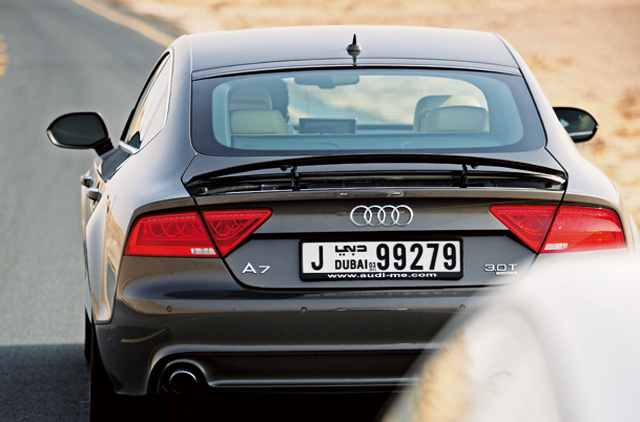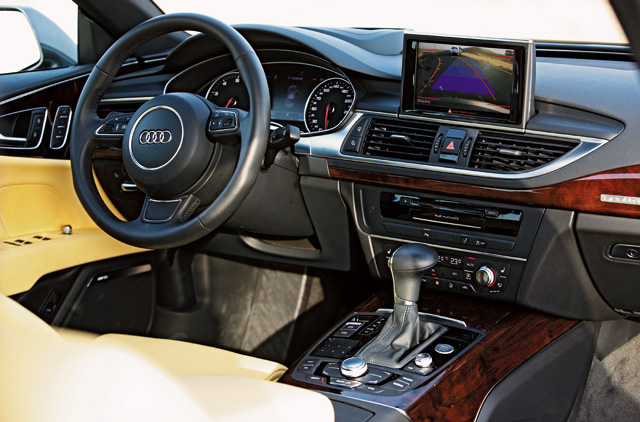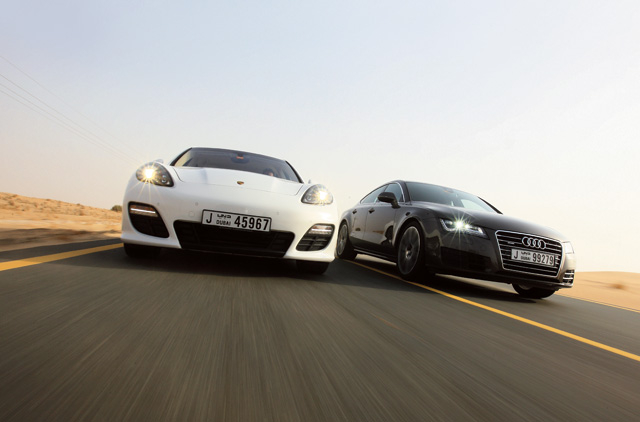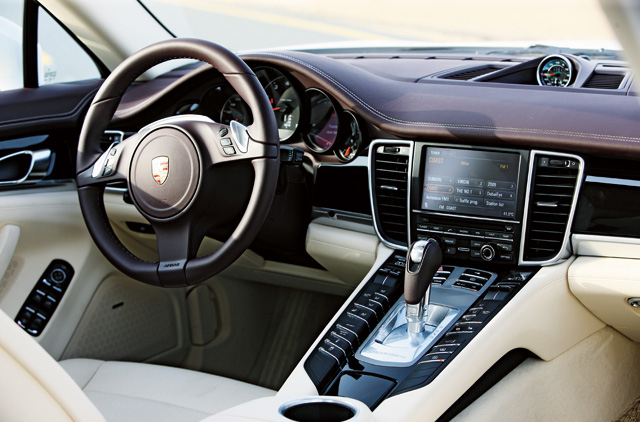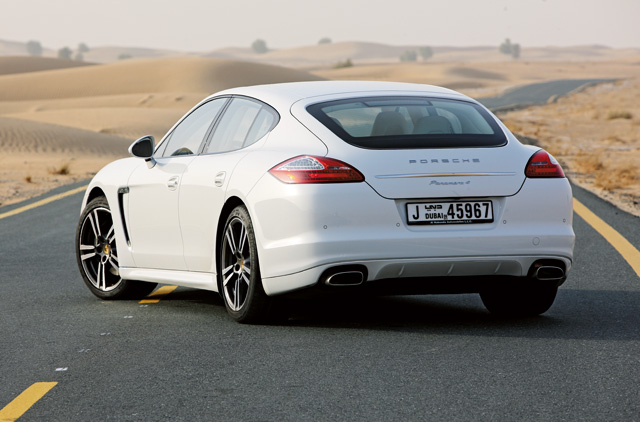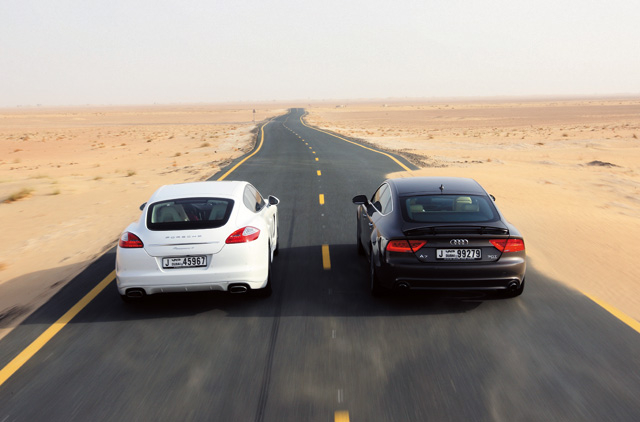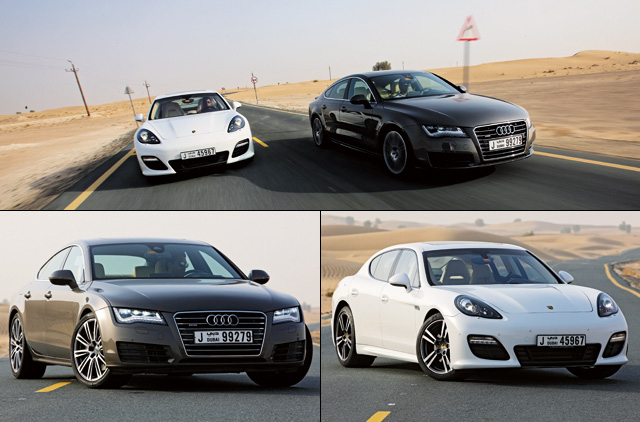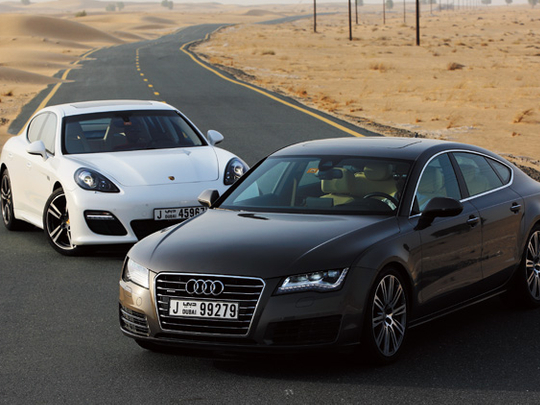
Car companies merge and buy each other and violently take over smaller rivals and enter into strategic partnerships (ahem, remember Daimler and Chrysler?) for one reason and one reason only: cost cutting.
These days when there's a family reunion at the Volkswagen household in Wolfsburg, Audi and Porsche are the bratty clashing cousins. Trying to get them to share technologies and cut costs together is like trying to get either to finish their broccoli.
That's why Audi and Porsche now offer their own lines of coupé-saloons, and the pair we've pitted against each other here are both all-wheel drive, both seat just four occupants, both have V6 engines, both produce exactly 300 horsepower, and both look spectacular. Hang on, something doesn't seem right here…
Anyway, it's peculiar that carsowned by the same family can beso fundamentally different andflush any cost-cutting and parts-sharing notions down the toilet. In fact, fundamental is too restricted a word, because they're actually different on every single level.
This is quite curious. So it got usto thinking… if papa Volkswagenis happy to have the children squabbling like this about their differences, we might as well adjudicate.
Dejan's Audi A7
If we had an engine-of-the-year award at our annual gathering of the best of the best, arguing over the winner would be the shortest argument ever. Everyone would just nod their heads in approval of Audi's torque-tastic force-fed 3.0-litre V6.
It's just a magical lump made of tornadoes, avalanches and a bit of aluminium. Audi has fitted it with direct injection, a supercharger (never mind that they call it a turbo, in Germany anything not naturally aspirated equals turbo) and paired it up with a seven-speed automatic transmission with its wet clutch swimming in oil. With that many ratios and the impossibility of ever catchinga whiff of burning clutch, forward progress is a constant surge of torque gnawing at the road below througha torque-sensing differential and all four wheels.
Foot flat to the floor, and this Audi A7 wafts off the line with instant power from idle, and then devours its seven gears without a single dip in the torque curve. And while I simply adore the free-revving nature of the other V6 here, Porsche's unit feels underpowered playing a waiting game to enter its power band, whereasthe Audi is in it from the get-go. Whatan engine!
And it's not like that's the A7's only talent. The aluminium panels drapedover its chassis have been sculpted by artists, sinking the car low down onto the road by elongating its ends, and filling its vast empty panels with simple detail touches. Note the rear fender for example. It's big, and it visually puts all the weight at the back (signifying rear-wheel drive: 60 per cent of the torque drives the rear axle), but to fool the eye and add some lightness to the car, Audi designers protruded the waistline to act as a sort of box-arch and kept the streak going into the taillamps and across the hatchback boot. It's so beautiful, you want to lick it.
Then, if you can tear yourself away from the engine's hypnotic hold, you'll notice the cabin bejewelled with satin polished metal trim, the kind of obsessively polished wood you see only on yachts, and leather from, presumably, genetically engineered cows. It's just flawless, as are the fittings and the ergonomics (except the oddly positioned start button — it's on the passenger's side). The coupé roofline coupled to a 4,969mm length and 2,914mm wheelbase (fractionally shorter than the Panamera 4), mean you can sit comfortably in the back, although it's strictly two rear passengers in there.
Bad bits? The steering is too artificial, too soft, and talks to you in a language you can't understand — Martian, I think. In the Porsche you can genuinely pretend you're steering a 911. The A7 makes up for it with impeccable composure in transitional bends, heaving the centre of its 1,770kg mass across and along its axes with more dexterity than the Porsche. But you won't carry as much entry speed as the Panamera 4 into the corners with the Audi's inclination towards understeer at the limit, where the Porsche simply pivots like a crab and then powers out witha lurching violence.
As sporty as the A7 is, its driving experience is still about grace and elegance. At least in the company of something from Zuffenhausen.
Specs & ratings
- Model A7
- Engine 3.0-litre V6, supercharged
- Transmission Seven-speed auto, AWD
- Max power 300bhp @ 5,250rpm
- Max torque 440Nm @ 2,900rpm
- Top speed 250kph (limited)
- 0-100kph 5.6sec
- Price Dh263,000
- Plus The constant gush of torque, design
- Minus Steering feel
Imran's Panamera 4
Football. It's a funny old game. How many times have we seen team selections consisting of three strikers, yet they all fail to score? Then, the team with the solitary target man often ends up scoring for fun. The point is, it doesn't matter how many you have in attack — if the team as a whole is strong and creative, then they'll stand a better chance of taking the spoils.
The same idea can be loosely applied to engines. A V8 should be stronger thana V6 since it has two extra cylinders. But, Porsche has downsized its motor for the all-wheel drive Panamera 4. It's lopped off two cylinders but its new 3.6-litre V6 still has plenty of firepower; 300 raging horses to be precise. How has it managed such a feat? By using direct injection, fully variable cam timing and dry-sump lubrication — the same ingredients as the big V8. Then, add to the mix the fabulous seven-speed PDK and its seamless shifts. This beauty helps to keep the engine in the sweet spot for longer, and you can also manually change gears via the paddles on the steering wheel, of course. Finally, it has shed a lot of weight. Compared with the 1,995kg of the heavyweight Panamera Turbo, the Panamera 4 tips the scales at just 1,822kg. It's a featherweight by comparison and as a result, it feels as nimble as one.
How does 0-100kph in 5.8 seconds and a top speed of 257kph sound? Granted, it lacks in low-end torque compared with the A7, but this isn't something designed for street racing. It's a smooth, sophisticated limo, don't forget.
It may be the least powerful Panamera but it is possibly the best-handling one. That is partly due to the drop in weight, but also the optional Porsche Active Suspension Management (PASM) and air suspension. You can change the characteristics of the chassis to Comfort, Sport or Sport Plus. Comfort is ideal for a relaxed drive. It feels soft but not excessively so, while Sport stiffens the steering, suspension and sharpens up the throttle response. For the ultimate thrill, dial it up to the third option and brace yourself for a wild ride. The PDK becomes exceptionally quick, the suspension stiffens up even more and the car jolts forward when you hit the loud pedal.
Throw in the Porsche Dynamic Chassis Control which more or less removes body roll, and a torque-vectoring system, and the Panamera starts feeling quite agile for what is a large saloon measuring 4,978mm long, 1,930mm wide and 1,417mm high. With short overhangs and muscular flanks, it boasts the classic Porsche design language. The powerfully curved fenders, characteristic headlights and sweeping roofline mean there's no confusing it for anything else.
The servotronic steering is sharp and precise and you always feel in control while it's hard to detect any artificial feel. It's far better than the understeer you get with the A7.
Our Panamera 4 rides on 20in 911 Turbo II wheels and features the SportDesign package; it certainly looks the part and also comes with bi-xenon headlights, dual-zone climate control, a 7in colour touchscreen sat-nav unit and a Bose surround-sound system. Throw in floor mats, Bluetooth handsfree technology and a host of connectivity features and it makes for quite an attractive package. There's a ton of extra kit to help you customise it even further — it'sa Porsche after all — so the optionslist is seemingly endless.
My only complaint is the amount of buttons scattered around the interior.Audi buries its tricks and treats in its brilliant MMI system, but Porsche has them all on display which can make hitting the right one a little tricky at times. And the seats don't feel as comfortableas the A7, but on the whole it certainly feels far more luxurious.
Finally, a word on economy. With a stop-start system which helps to bring fuel consumption down to a very agreeable9 litres-per-100km, the Panamera 4 won't burn a hole in your pocket.
Verdict
If we're going by value for money, then the A7 offers a better deal. It's over Dh100,000 less than the Panamera 4 and thanks to its supercharged V6, it's noticeably faster too (at least if the road is dead straight), leaving the Porsche behind in a drag race. If it wasn't for the limited top speed of 250kph, the speedo needle would just spin round and round. Torque rules on the streets and the A7 has bagloads of it, but needless to say, you wouldn't want to be racing in either of these luxury limos.
So, where do they stand when it comes to style and comfort and all the rest of it? Well, Audis are well known for their sturdy interiors and the A7 is certainly a lovely place to be, no doubt. However, the Porsche just about seals the bragging rights here. It's very well appointed, it looks far more luxurious and even though the centre console may seem cluttered at first, it's actually a strong selling point. You kind of want to see all the buttons and special features, not hide them away like in the A7.
At first the cars' family relations suggest there isn't much to choose between them, until you glance at their prices and experience the magic of the Audi's endless torque. Sorry Porsche, you don't eat your broccoli, you don't get your dessert.
Specs & ratings
- Model Panamera 4
- Engine 3.6-litre V6
- Transmission Seven-speed PDK, AWD
- Max power 300bhp @ 6,200rpm
- Max torque 400Nm @ NA
- Top speed 257kph
- 0-100kph 5.8sec
- Price Dh393,100
- Plus It almost feels like a 911
- Minus New V6 is good but it lacks in low-end torque


